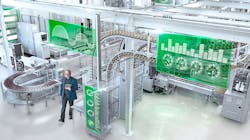Schneider Electric sets up the first industrial microgrid in Spain with ACCIONA Energía
Schneider Electric and renewable energy utility firm ACCIONA Energía have set up the first microgrid in Spain at Schneider Electric’s plant in Puente la Reina. The firms have installed the microgrid on an “energy as a service” (EaaS) basis, wherein ACCIONA Energía owns the microgrid and is responsible for its regular maintenance and management.
The microgrid includes 852kW of photovoltaic energy, five EV charging points and 80kWh of battery storage. The microgrid is controlled by Schneider Electric’s EcoStruxure EMA software. It has lower energy costs and higher efficiency.
The project’s aim is to continue with the energy transition using distributed energy resources, sustainability and digitalization.
Microgrids facilitate the integration of key elements for the energy transition such as renewable energy sources, electric vehicles and battery storage to provide more resilient and reliable supplies. They can function disconnected from the main grid, either isolated or connected, with active management of the energy to optimize costs.
About the Author
EnergyTech Staff
Rod Walton is senior editor for EnergyTech.com. He has spent 17 years covering the energy industry as a newspaper and trade journalist.
Walton formerly was energy writer and business editor at the Tulsa World. Later, he spent six years covering the electricity power sector for Pennwell and Clarion Events. He joined Endeavor and EnergyTech in November 2021.
He can be reached at [email protected].
EnergyTech is focused on the mission critical and large-scale energy users and their sustainability and resiliency goals. These include the commercial and industrial sectors, as well as the military, universities, data centers and microgrids.
Many large-scale energy users such as Fortune 500 companies, and mission-critical users such as military bases, universities, healthcare facilities, public safety and data centers, shifting their energy priorities to reach net-zero carbon goals within the coming decades. These include plans for renewable energy power purchase agreements, but also on-site resiliency projects such as microgrids, combined heat and power, rooftop solar, energy storage, digitalization and building efficiency upgrades.
